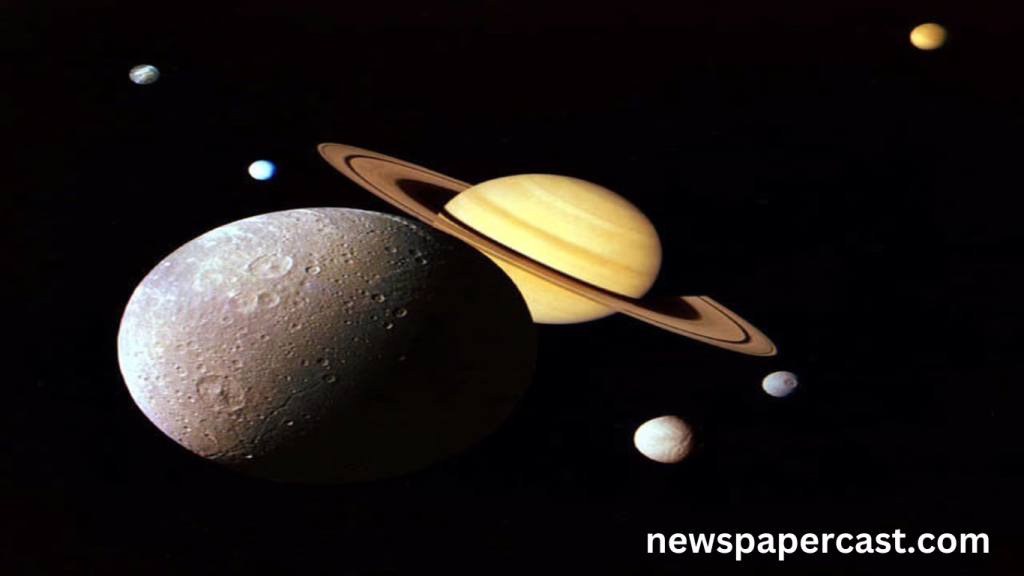Saturn has long held the title of one of the most mysterious and majestic planets in our solar system. Now, with the discovery of 128 new moons, scientists are digging deeper into what this might mean for the planet’s violent history and the dynamics of its orbiting bodies
A Giant Leap in Moon Counting
Astronomers recently announced a staggering increase in Saturn’s moon count. Using advanced observational techniques and powerful telescopes, researchers tracked tiny specks orbiting the gas giant. What they found wasn’t just a handful of new moons—it was a population explosion
The Power of Modern Sky Surveys
These new moons weren’t discovered overnight. They are the result of years of sky surveys, image stacking, and software-assisted tracking. Small, irregularly shaped, and often faint, many of these moons would have been invisible to earlier generations of astronomers
Clues to Ancient Cosmic Violence
Scientists suspect that these new moons may be remnants of catastrophic collisions. Evidence suggests that larger moons in Saturn’s past may have shattered due to impacts with asteroids or other celestial objects. The fragments from such collisions could still be orbiting the planet today as these newfound moons
Irregular Moons with Irregular Orbits
Unlike Saturn’s major moons, many of these new objects follow strange, looping paths. Some move in retrograde motion—meaning they orbit in the opposite direction of Saturn’s rotation. These odd orbits support the theory that the moons are captured fragments rather than bodies that formed alongside Saturn
Comparing Saturn and Jupiter
Jupiter once held the record for the most moons, but with this discovery, Saturn has taken the lead. This moon race highlights not just the numerical competition but also the different histories and environments of the two gas giants. Saturn’s more active ring and satellite system could point to a more collision-filled past
Unlocking the Secrets of Planetary Evolution
The discovery adds an important chapter to the study of how planetary systems evolve. The presence of so many irregular moons hints at a chaotic past filled with destruction, rebirth, and gravitational reshaping. These tiny moons act like breadcrumbs pointing scientists toward the events that shaped the outer solar system
Future Missions May Offer New Insight
With interest growing around Saturn’s complex moon system, future space missions may target the planet once again. More detailed studies could confirm the origins of these moons, explore their composition, and even investigate the possibility of hidden subsurface oceans in some of the larger fragments
A New Era for Moon Mapping
Saturn’s moon count is no longer a fixed number but a changing, evolving story. As technology improves, astronomers will likely uncover even more hidden moons around the giant planets. Each one offers a new clue, a new mystery, and a deeper understanding of the forces that continue to shape our solar system.
Frequently Asked Questions
What led to the discovery of Saturn’s 128 new moons?
Astronomers used advanced telescopes and techniques like image stacking and long-term tracking to identify faint, distant objects orbiting Saturn. Over time, these observations confirmed the presence of 128 previously undetected moons.
Why weren’t these moons discovered earlier?
Most of the new moons are small, irregular, and very faint. Earlier instruments lacked the sensitivity to detect them, but recent advancements in digital imaging and sky surveys made it possible to spot even the tiniest objects.
Are all of Saturn’s moons the same size?
Not at all. While Saturn has large moons like Titan, many of the newly discovered ones are only a few kilometers across. Their small size and dim light make them difficult to detect without precise tools and long observation periods.
What makes scientists think these moons are from past collisions?
Many of the new moons have irregular shapes and unusual orbits, which suggest they didn’t form alongside Saturn but were created from larger moons that broke apart in violent impacts or were captured by Saturn’s gravity after space collisions.
Do these moons affect Saturn’s rings?
Some may play a role in shaping or maintaining the rings, especially if they pass close to the ring material. Their gravitational pull can influence particle movement, but most of the newly discovered moons orbit much farther away.
How do these moons orbit differently from Saturn’s significant moons?
Unlike major moons that orbit in a clean, circular path, many of the new moons have tilted, eccentric, or even retrograde orbits. This irregularity is a strong clue pointing to their origin as collision fragments or captured bodies.
Does Saturn now have the most moons in the solar system?
Yes, with 128 newly confirmed moons, Saturn has reclaimed the title from Jupiter. However, this number may change as more discoveries are made or existing objects are reclassified.
Could any of these new moons support life?
It’s doubtful. Most of these moons are small, rocky, and lack atmospheres or internal heat sources. However, studying them can still provide important information about the conditions in the early solar system.
Conclusion
The discovery of Saturn’s 128 new moons opens an exciting window into the planet’s dynamic and possibly violent history. These tiny, irregular bodies may be the shattered remains of ancient celestial collisions, offering vital clues about the evolution of Saturn’s orbiting system. As technology advances, continued exploration of these moons will deepen our understanding of the solar system’s past and the powerful forces that continue to shape it today.

